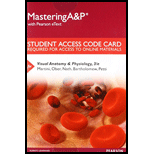
Introduction: A cell is the fundamental unit of life. All living organisms are made up of one or many cells. The organisms are classified as prokaryotes and eukaryotes.
Answer to Problem 1CRQ
Correct answer: Option b) “Cells combine to form tissues.”
Explanation of Solution
Reason for the correct answer:
Option b) is given as “Cells combine to form tissues”.
The cell theory states that a cell is the basic structural unit among living organisms and cells arise from pre-existing cells. This theory has three principles as follows:
- A cell is the smallest unit of structure and functions in living organisms.
- All living beings are made up of one or more number of cells. Basically, cells are the building blocks of all animals and plants.
- New cells are formed from pre-existing cells and pass the genetic material to the offspring.
Similar types of cells combines to form tissues, but it is not the characteristic of the cell theory because not all organisms are multicellular and have the tissue level organization.
Hence, option b) is correct.
Reasons for incorrect answers:
Option a) is given as “Cells are the building blocks of life”. It is one of the characteristics of the cell theory. Hence, option a) is incorrect.
Option c) is given as “All new cells come from the division of pre-existing cells”. It is one of the characteristics of the cell theory. Hence, option c) is incorrect.
Option d) is given as “Cells are the smallest units that perform all vital physiological functions”. It is one of the characteristics of the cell theory. Hence, option d) is incorrect.
Therefore, options a), c), and d) are incorrect.
Cells combine to form tissues is not a characteristic of the cell theory.
Want to see more full solutions like this?
Chapter 3 Solutions
Masteringa&p With Pearson Etext -- Standalone Access Card -- For Fundamentals Of Anatomy & Physiology (11th Edition)
- What are the main principles of the cell theory?arrow_forwardWhat is cell biology?arrow_forwardWhat are the units that constitute the unit of the cell? Why are they not classified under biological organization?What will likely happen to the other units (higher and lower) if one unit from the hierarchy is removed or suffers irreversible damage? What can be an example for this?arrow_forward
- Which of the following statements is NOT true about the cell theory? a. All cells arise spontaneously. b. All cells arise from preexisting cells. c. All living organisms are made up of cells. d. Cell is the basic unit of life.arrow_forwardCan anyone describe how organelles interact to secrete, use energy, and clean up debris?arrow_forwardWhat is cell body?arrow_forward
- . Which of the following is not a part of the cell theory? a Cells come from pre-existing cells. b All living organisms are composed of cells. c The basic unit of life is the cell. d Cells contain membrane-bound organelles.arrow_forwardWhat is the function of Cell Volume?arrow_forwardThe interior of a cell is divided into which two regions?arrow_forward
 Human Anatomy & Physiology (11th Edition)BiologyISBN:9780134580999Author:Elaine N. Marieb, Katja N. HoehnPublisher:PEARSON
Human Anatomy & Physiology (11th Edition)BiologyISBN:9780134580999Author:Elaine N. Marieb, Katja N. HoehnPublisher:PEARSON Biology 2eBiologyISBN:9781947172517Author:Matthew Douglas, Jung Choi, Mary Ann ClarkPublisher:OpenStax
Biology 2eBiologyISBN:9781947172517Author:Matthew Douglas, Jung Choi, Mary Ann ClarkPublisher:OpenStax Anatomy & PhysiologyBiologyISBN:9781259398629Author:McKinley, Michael P., O'loughlin, Valerie Dean, Bidle, Theresa StouterPublisher:Mcgraw Hill Education,
Anatomy & PhysiologyBiologyISBN:9781259398629Author:McKinley, Michael P., O'loughlin, Valerie Dean, Bidle, Theresa StouterPublisher:Mcgraw Hill Education, Molecular Biology of the Cell (Sixth Edition)BiologyISBN:9780815344322Author:Bruce Alberts, Alexander D. Johnson, Julian Lewis, David Morgan, Martin Raff, Keith Roberts, Peter WalterPublisher:W. W. Norton & Company
Molecular Biology of the Cell (Sixth Edition)BiologyISBN:9780815344322Author:Bruce Alberts, Alexander D. Johnson, Julian Lewis, David Morgan, Martin Raff, Keith Roberts, Peter WalterPublisher:W. W. Norton & Company Laboratory Manual For Human Anatomy & PhysiologyBiologyISBN:9781260159363Author:Martin, Terry R., Prentice-craver, CynthiaPublisher:McGraw-Hill Publishing Co.
Laboratory Manual For Human Anatomy & PhysiologyBiologyISBN:9781260159363Author:Martin, Terry R., Prentice-craver, CynthiaPublisher:McGraw-Hill Publishing Co. Inquiry Into Life (16th Edition)BiologyISBN:9781260231700Author:Sylvia S. Mader, Michael WindelspechtPublisher:McGraw Hill Education
Inquiry Into Life (16th Edition)BiologyISBN:9781260231700Author:Sylvia S. Mader, Michael WindelspechtPublisher:McGraw Hill Education





